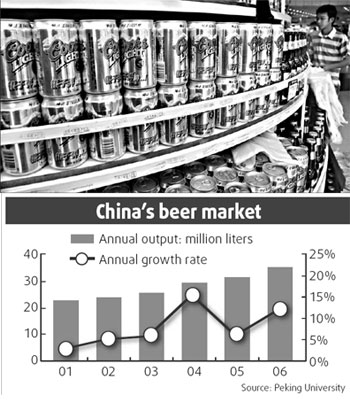Beer firms must focus on top end
By Zhang Jingtian (China Daily)Updated: 2007-05-24 09:00
To fend off international giants from gobbling up Chinese market share, local beer makers need to produce profitable beers aimed at the high-end market.
There's no doubt the local premium beer market is the key to long-tern growth: profits from one bottle of high-end beer are over 10 times of that of a low-end substitute.
Additionally, market size is growing rapidly. It's estimated that by the end of 2010, China will have the largest middle-class in the world at over 490 million.
Public entertainment venues, including KTV, cafs and Western-style
restaurants and bars, are the hottest sellers of premium beers. Take Beijing's
many bars, for example. There are about 500 bars in the capital, dotted around
Sanlitun, Houhai, Chaoyang Park and Weigongcun. 
A recent study shows about 70 percent of beer consumption takes place in bars.
Frequent bar visitors usually come from the middle-class. They are around 35 years old, fashionable and generous spenders.
Local beer producers have been losing ground to international competitors in China's high-end market.
Their sales volume may be smaller, but international brands continue to grow in China simply because they dominate the lucrative high-end market.
They are also strengthening efforts to increase their share of the pie. Companies such as UK-based InBev and Canadian-based Molson Coors are launching their best-selling premium brands in China and are seeking out mergers and acquisitions to increase local market share.
Their marketing strategy is simple but straightforward - target the bars. The study indicates four major international breweries are best sellers in Beijing's bars, and 90 percent of bars are selling all four brands, including US-based Budweiser, Holland-based Heineken, Denmark-based Carlsberg, and Mexico-based Corona.
But local brands are trying to catch with their global competitors.
In 2005, two local brands - Tsingtao and Yanjing - entered the Top 10 World Brewery Brands list, ranking ninth and tenth place respectively.
In recent years, the top three local brands - Tsingtao, Yanjing and China Resources Snow - have been leading the way by throwing huge sums of money into high-end brands, which has lifted sales volume and revenue. Pearl River Beer, Harbin Beer, Kingway Beer and Chongqing Beer have all followed with premium brands.
But there seems to be only a small difference between the high-end products and other brands, and local beers sell for much less than international competitors.
More importantly, local brands haven't caught on in the bars and suffer from weak marketing and promotional initiatives.
According to the study, about 70 percent of Beijing's bars sell Tsingtao beer, and just 14 percent sell Yanjing beer.
There is always a misconception circling the brewery industry that says local brands can't compete with international ones.
This statement is false.
Local brands can eventually succeed through strategic and innovating marketing campaigns. After all, there is little difference between the brewery techniques of local and global brands.
In terms of branding, local brewers should promote unique taste, top-quality packaging and novelty brand names. Marketing initiatives should be consistent and comprehensive.
Prices should be set at the average premium level, or offered at a higher price than international brands to draw consumers' attention.
Setting up at bars that only serve local brands' high-end beers is another effective practice, although it is costly. From a long-term perspective, the practice will drive profits and brand image as well.
Lastly, local manufactures should be trendsetters and create innovate lifestyle concepts whenever launching a new product.
The author is an expert in beer marketing.
(For more biz stories, please visit Industry Updates)